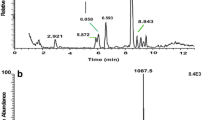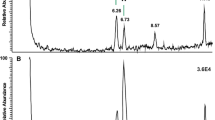Abstract
Biological activities of crustacean cardioactive peptide (CCAP; PFCNAFTGCa) and leucomyosuppressin (Lem-MS; pQDVDHVFLRFa) were studied in heterologous bioassays in the larvae and adults of Tenebrio molitor. CCAP exerted a reversible and dose-dependent cardio-stimulatory effect on the semi-isolated heart of the experimental beetles at a concentration of >10−7 M and induced an effect similar to the endogenic cardio-stimulatory peptide, proctolin. Injections of CCAP (10−9–10−3 M) into 4-day-old adult reproductive females increased the concentration of soluble proteins in hemolymph in comparison to the saline injected controls. Electrophoretic analyses indicated significant increase in the level of two proteins 130 and 170 kDa, and a partial increase of the level of 67-kDa protein. The studies indicated that CCAP increased also free hemolymph sugar concentration in young larvae and adults of the mealworm beetle. The cardio-inhibitory peptide Lem-MS exerted the opposite effect: at concentration 10−7–10−6 M, it significantly decreased the heartbeat frequency. The induced changes were dose-dependent and reversible, but at higher concentrations (>10−5 M) the stimulatory effect disappeared. Injections of the Lem-MS into young larvae at concentrations 10−9–10−3 M, also increased the free hemolymph sugar level similarly to the CCAP. This work demonstrates the pleiotropic effects of CCAP and Lem-MS in Tenebrio molitor.






Similar content being viewed by others
References
Bradford MM (1976) A rapid and sensitive method for the quantification of microgram quantities of protein utilizing the principle of protein–dye binding. Anal Biochem 72:248–254
Breidbach O, Urbach R (1996) Embryonic and postembryonic development of serial homologous neurons in the subesophageal ganglion of Tenebrio molitor (Insecta: Coleoptera). Microsc Res Tech 35:180–200
Cuthbert BA, Evans PD (1989) A comparision of the effects of FMRFamide-like peptides on locust heart and skeletal muscle. J Exp Biol 144:395–415
Cheung CC, Loi PK, Sylwester AW, Lee TD, Tublitz NJ (1992) Primary structure of a cardioactive neuropeptide from the tobacco hawkmoth, Manduca sexta. FEBS Lett 313:165–168
Coast GM (1998) The influence of neuropeptides on Malpighian tubule writhing and its significance for excretion. Peptides 19:549–560
Dircksen H (1998) Conserved crustacean cardioactive peptide (CCAP) neuronal networks and functions in arthropod evolution. In: Coast GM, Webster SG (eds) Recent advances in arthropod endocrinology. Cambridge University Press, London, pp 302–334
Donini A, Lange AB (2002) The effects of crustacean cardioactive peptide on locust oviducts are calcium-dependent. Peptides 23:683–691
Donini A, Agricola HJ, Lange AB (2001) Crustacean cardioactive peptide is a modulator of oviduct contraction in Locusta migratoria. J Insect Physiol 47:277–285
Dubois M, Gilles KA, Hamilton JK, Rebers PA, Smith F (1956) Colorimetric method for determination of sugars and related substances. Anal Chem 28:350–356
Dulcis D, Levine RB, Ewer J (2005) Role of the neuropeptide CCAP in Drosophila cardiac function. J Neurobiol 64:259–274
Duve H, Johnsen AH, Sewell JC, Scott AG, Orchard I, Rehfeld JF, Thorpe A (1992) Isolation, structure and activity of -Phe-Met-arg-Phe-NH2 neuropeptides (designated calliFMRFamides) from the blowfly Calliphora vomitoria. Proc Natl Acad Sci USA 89:2326–2330
Furuya K, Liao S, Reynolds SE, Ota RB, Hackett M, Schooley DA (1993) Isolation and identification of a cardioactive peptide from Tenebrio molitor and Spodoptera eridania. Biol Chem 374:1065–1074
Gäde G, Rosiński G (1990) The primary structure of the hipertrehalosemic neuropeptide from tenebrionid beetles; a novel member of the AKH/RPCH family. Peptides 11:455–459
Gäde G, Hoffman KH, Spring JH (1997) Hormonal regulation in insect: facts, gaps and future directions. Physiol Rev 77:963–1032
Gammie SC, Truman JW (1999) Eclosion hormone provides a link between ecdysis-triggering hormone and crustacean cardioactive peptide in the neuroendocrine cascade that controls ecdysis behavior. J Exp Biol 202:343–352
Holman GM, Cook BJ, Nachman RJ (1986) Isolation, primary structure and synthesis of leucomyosuppressin, an insect neuropeptide that inhibits spontaneous contractions of the cockroach hindgut. Comp Biochem Physiol C 85:329–333
Keeley LL, Hayes TK, Bradfield JY, Sowa SM (1991) Physiological actions by hypertrehalosemic hormone and adipokinetic peptides in adult Blaberus discoidalis cockroaches. J Insect Physiol 21:121–129
Kingan TG, Teplow DB, Phillips JM, Riehm JP, Rao KR, Hildebrand JG, Homberg U, Kammer AE, Jardine I, Griffin PR, Hunt DF (1990) A new peptide in the FMRFamide family isolated from the CNS of the hawkmoth, Manduca sexta. Peptides 11:849–856
Kodrík D (2008) Adipokinetic hormone functions that are not associated with insect flight. Physiol Entomol 33. doi:10.1111/j.1365-3032.2008.00625.x
Laemmli UK (1970) Cleavage of structural proteins during the assembly of the head of bacteriophage T4. Nature 227:680–685
Li B, Predel R, Neupert S, Hauser F, Tanaka Y, Cazzamali G, Williamson M, Arakane Y, Verleyen P, Schoofs L, Schachtner J, Grimmelikhuijzen C, Park Y (2008) Genomics, transcriptomics, and peptidomics of neuropeptides and protein hormones in the red flour beetle Tribolium castaneum. Genome Res 18:113–122
Ludwig D, Fiore C (1960) Further studies on the relationship between parental age and the life cycle of the mealworm, Tenebrio molitor. Ann Ent Soc Am 53:595–600
Ludwig D, Fiore C, Jones R (1962) Physiological comparison between offspring of the yellow mealworm, Tenebrio molitor, obtained from young and from old parents. Ann Entomol Soc Am 55:439–442
Mercier J, Doucet D, Retnakaran (2007) Molecular physiology of crustacean and insect neuropeptides. J Pestic Sci 32(4):345–359
Nichols R (1992) Isolation and structural characterization of Drosophila TDVDHVFLRFamide and FMRFamide-containing neural peptides. J Mol Neurosci 3:213–218
Peeff NM, Orchard I, Lange AB (1993) The effects of FMRFamide-related peptides on an insect (Locusta migratoria) visceral muscle. J Insect Physiol 39:207–215
Predel R, Wegener C (2006) Biology of the CAPA peptides in insects. Cell Mol Life Sci 63:2477–2490
Predel R, Rapus J, Eckert M (2001) Myoinhibitory neuropeptides in the American cockroach. Peptides 22:199–208
Robb S, Packman LC, Evans PD (1989) Isolation, primary structure and bioactivity schistoFLRF-amide, a FMRF-amide-like neuropeptide from the locust, Schistocerca gregaria. Biochem Biophys Res Commun 160:850–856
Rosiński G (1995) Metabotropic and myotropic peptides from insects. Seria Zoologica, vol 22. UAM, Poznań
Rosiński G, Gäde G (1988a) Hyperglycaemic and myoactive factors in the corpora cardiaca of the mealworm, Tenebrio molitor L. J Insect Physiol 34:1035–1042
Rosiński G, Gäde G (1988b) Physiological effect of corpus cardiacum extracts in Tenebrio molitor L. In: Sehnal F, Zabza A, Denlinger DL (eds) Endocrinological frontiers in physiological insect ecology. Wroclaw Technical University Press, Wroclaw, pp 651–654
Rosiński G, Wrzeszcz A, Obuchowicz L (1979) Differences in trehalase activity in the intestine of fed and starved larvae of Tenebrio molitor L. Insect Biochem 9:485–488
Sakai T, Satake H, Minakata H, Takeda M (2004) Characterization of crustacean cardioactive peptide as a novel insect midgut factor: isolation, localization, and stimulation of alpha-amylase activity and gut contraction. Endocrinology 145:5671–5678
Schoofs L, Holman GM, Peamen L, Veelaert D, Amelinck M, De Loof A (1993) Isolation, identification and synthesis of PDVDHVFLRFamide (SchistoFLRFamide) in Locusta migratoria and its association with the male accessory glands, the salivary glands, the head and the oviduct. Peptides 14:409–421
Schoofs L, Clynen E, Cerstiaens A, Baggerman G, Wei Z, Vercammen T, Nachman R, De Loof A, Tanaka S (2001) Newly discovered functions for some myotrpic neuropeptides in locust. Peptides 22:219–227
Skonieczna M, Rosiński G (2004) Cardioactive effects of FMRFamide-related peptides in beetles, Tenebrio molitor and Zophobas atratus. Pesticides 3–4:33–39
Stangier J, Hilbich C, Beyreuther K, Keller R (1987) Unusual cardioactive peptide (CCAP) from pericardial organs of the shore crab Carcinus maens. Proc Natl Acad Sci USA 84:575–579
Stangier J, Hilbich C, Keller R (1989) Occurance of crustacean cardioactive peptide (CCAP) in the nervous system of an insect, Locusta migratoria. J Comp Physiol 159:5–11
Tublitz N (1989) Insect cardioactive peptides. Neurohormonal regulation of cardiac activity by two cardioacceleratory peptides during flight in the tobacco hawkmoth, Manduca sexta. J Exp Biol 142:31–48
Tublitz N, Alen AT, Cheung CC, Edwards KK, Kimble DP, Loi PK, Sylwester AW (1992) Insect cardioactive peptides: regulation of hindgut activity by cardioacceleratory peptide 2 (CAP 2) during wandering behaviour in Manduca sexta. J Exp Biol 165:241–264
Ullmann SL (1973) Oogenesis in Tenebrio molitor: histological and autoradiographical observations on pupal and adult ovaries. J Embryol Exp Morphol 30:179–217
Veelaert D, Passier P, Devreese B, Vanden Broeck J, Van Beeumen J, Vullings HGB, Diederen JHB, Schoofs L, De Loof A (1997) Isolation and characterization of an adipokinetic hormone release-inducing factor in locust: the crustacean cardioactive peptide. Endocrinology 138:138–142
Veelaert D, Schoofs L, De Loof A (1998) Peptidergic control of the corpus cardiacum–corpora allata complex of locust. Int Rev Cytol 182:249–302
Vullings HGB, Diederen JHB, Veelaert D, Van der Horst DJ (1999) Multifactorial control of the release of hormones from the locust retrocerebral complex. Microsc Res Tech 45:142–153
Wang Z, Orchard I, Lange A, Chen X, Starratt AN (1995) A single receptor transduces both inhibitory and stimulatory signals of FMRFamide-related peptides. Peptides 16:1181–1186
Weaver RJ, Audsley N (2008) Neuropeptides of the beetle, Tenebrio molitor identified using MALDI-TOF mass spectrometry and deduced sequences from the Tribolium castaneum genome. Peptides 29(2):168–178
Acknowledgments
Contract grant sponsor: Grant no. 3P04C 03724 and 2P04C 04928 from the State Committee for Scientific Research, Poznań, Poland. This study was supported by grant no. 3P04C03724 and 2P04C04928 from the State Committee for Scientific Research. The authors thank Dr. Natraj Krishnan, Department of Zoology, Oregon State University and Dr. Dalibor Kodrik, Institute of Entomology, Biological Center CAS for their critical remarks and help in correcting the language of the manuscript.
Author information
Authors and Affiliations
Corresponding author
Additional information
Communicated by G. Heldmaier.
Rights and permissions
About this article
Cite this article
Wasielewski, O., Skonieczna, M. Pleiotropic effects of the neuropeptides CCAP and myosuppressin in the beetle, Tenebrio molitor L.. J Comp Physiol B 178, 877–885 (2008). https://doi.org/10.1007/s00360-008-0276-6
Received:
Revised:
Accepted:
Published:
Issue Date:
DOI: https://doi.org/10.1007/s00360-008-0276-6




